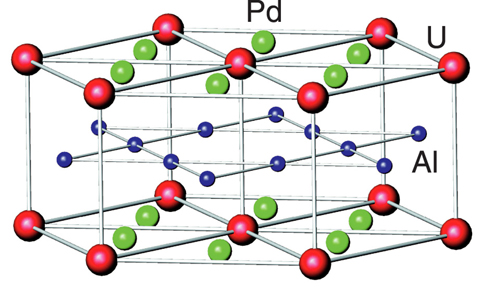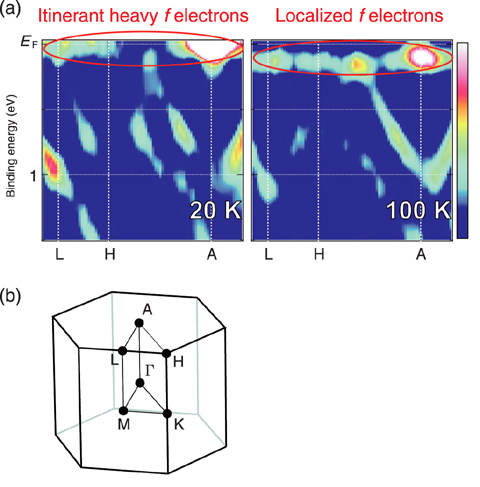
Fig.4-23 Crystal structure of UPd2Al3

Fig.4-24
Electrons in solids have been conventionally classified as being either freely moving, "itinerant" , or bound to atom lattices, "localized" , depending on their properties. These opposing properties of electrons are both well understood. For heavy Fermion (HF) compounds, however, the f electrons display both itinerant and localized behavior depending on temperature. At high temperatures, their magnetic properties are well described by the ionic ƒ-electron models, suggesting that the ƒ-electrons behave as localized electrons. On the other hand, at low temperatures, their behaviors can be explained well by the "itinerant" ƒ-electron model with heavy electron mass. These two models ascribe totally different natures to ƒ-electrons, and how they transform between the localized and itinerant state as a function of temperature has never been understood on the level of their electronic structures. Furthermore, some HF compounds show unconventional superconductivity at very low temperatures, and have attracted much attention in recent years. Here we studied the band structure of the HF antiferromagnetic superconductor UPd2Al3 at low temperatures and high temperatures by angle-resolved photoelectron spectroscopy (ARPES), and discovered the temperature dependence of the electronic structure. Fig.4-23 shows the crystal structure of UPd2Al3. Fig.4-24 shows the band structure of UPd 2Al 3 measured at 20 K and 100 K. At low temperature, 5ƒ bands form a Fermi surface, suggesting that they have itinerant properties. On the other hand, at high temperature, the ƒ-bands move toward higher binding energies, and are excluded from the Fermi surface. The present results demonstrate at the level of electronic structure how the same ƒ-electrons can show both itinerant and localized behavior, and provide important information for a consistent description of the localized and itinerant nature of HF compounds. Moreover, we could clarify the band structure of HF superconductor for the first time. This is key information for the understanding of the unconventional superconductivity of HF compounds.